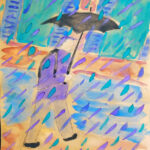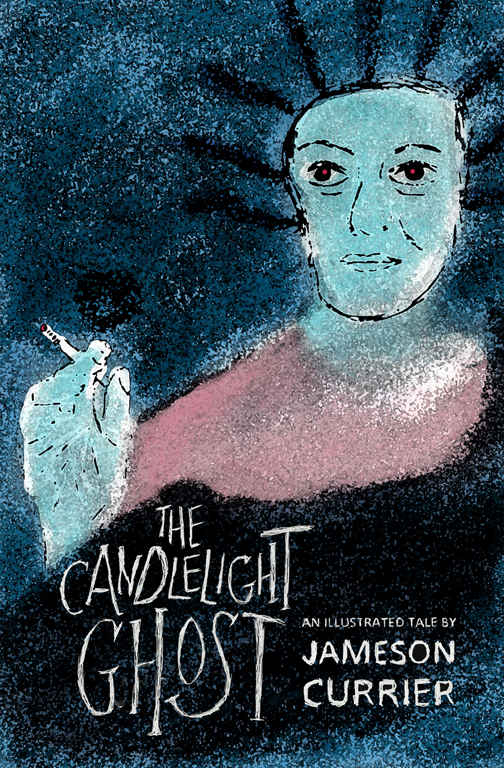
“Heaven is a meal at my favorite restaurant in New Orleans”
art by Jameson Currier
Pencil, pastel, and ink on paper, hand painted
Private collection
20170704005
The Happiness of Pursuit
art and text by Jameson Currier
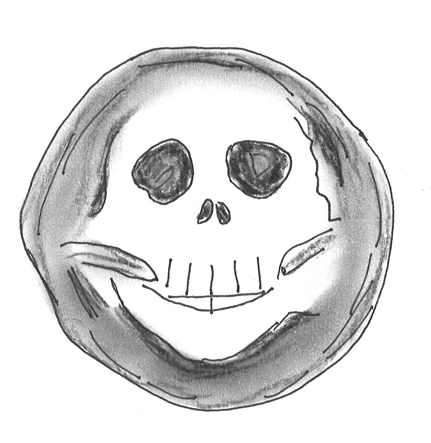
March 23, 2017: I’d seen the skulls from the shuttle bus I had taken to the French Quarter from the airport—images molded on greenish ochre colored plates with swirls of white paint and dark hollow eyes. They possessed a haunting, gloomy beauty that could not be overlooked, though I had no idea what they would be used for except to be put on display or to jump start a conversation. They were in the window of a store selling kitchen and cooking specialty items, souvenirs, and gifts, and I made a mental note of their whereabouts, about three blocks from the hotel where I was staying.
I didn’t seek them out that first evening. Travel tires me because I invest too much time in it even when I try to simplify it—I had flown non-stop from New York but had arrived at the airport hours too early. Now it was dinner time and I had an anxious hunger so I only crossed the block from my hotel to eat at the seafood restaurant I dine at every year on the first night of my stay in the Crescent City. I never take a table since I am dining alone—it’s a loud, noisy boisterous restaurant full of locals and tourists, families and frat boys and coworkers arriving in large groups. I always sit at the bar near the waiters’ station, ordering the same crab platter year after year, now going on for more than a decade. But tonight there was not a seat at the bar at all—I couldn’t even compromise and take a different seat. I waited in the reservation line to ask if there might be a table for one—something I knew would be impossible—but there were so many groups with special needs I was defeated in even getting the receptionist’s attention, so I walked out the door. Another place would be fine, I decided, there are so many undiscovered eateries in New Orleans, which is part of its charm. It was a glorious spring evening, temperature in the low 70s with the undertone of humidity that always belies more tropical locations, though as usual in New Orleans my gray hair—what I have left of it—decided to plump and curl—and the T-shirt I wore beneath my polo shirt began to moisten with sweat. I walked a block, looking for a new place I hadn’t noticed before, got distracted by watching a weddingparty parade through the streets, then decided to return to the restaurant again, thinking someone might have departed their seat at the bar, or perhaps I would just wait for a vacancy. It was my favorite restaurant in New Orleans. It was where I always dined on my first night in the French Quarter and where I wanted to eat that night.
Inside the restaurant again, I noticed a woman arranging to pay for her order at the exact seat at the bar that I desired. I went over and stood behind her, trying not to look impatient, taking her seat before her dishes and napkins had been cleared from the counter. But soon enough I had a glass of wine and the crab platter was on its way. It was an amazing feast: crab au gratin, stuffed crabs, deep fried crab claws, and a soft shell crab, all on a bed of French fries with dips of horseradish, cocktail sauces, and ketchup at hand. Not a healthy, gluten-free calorie to be found. An hour later I crossed the block and was back in my hotel room, satiated, lying in bed, flipping channels on the oversized TV with a remote control.

The next morning I dressed and walked to the hotel where I was attending a literary conference and picked up my registration material. The weather was swampier than the day before and my head was cloudy, perhaps from overeating too much seafood the night before, but my mission was to walk as much as possible throughout the day, in hopes that the exercise would release the tension I had carried from my day job in New York, and, more importantly, to jump start the weight I wanted to loose. Yes, that’s right, at that moment I naively, or, rather, stupidly, thought I could lose weight while visiting New Orleans. But an appointment the week before with my cardiologist had ended with my doctor’s stern suggestion that my expanding weight was getting too much to overlook. My weight is something that rattles me every day. I see my lost youth in mirrors and reflections and in the invisibility of others’ eyes.
The cooking store was a block from the conference hotel, and having remembered the skull plates, I decided to examine them further. Since the aftermath of Katrina—more than a decade before—every year when I attend this conference in New Orleans, I try to purchase something special—nothing extravagant, but at least significant for me and hopefully the trader—I have commissioned paintings from local artists, one year I tossed a chuck of money into an open violin case in Jackson Square after hearing a young man and his wife, both violinists, play soaring melodies while a baby, less than a year old, hung from a knapsack on the man’s back, another time I had my fortune told by a woman who seemed to be a drag queen imitating Barbra Streisand and purchased her overpriced scented candles and good vibe voodoo charms.
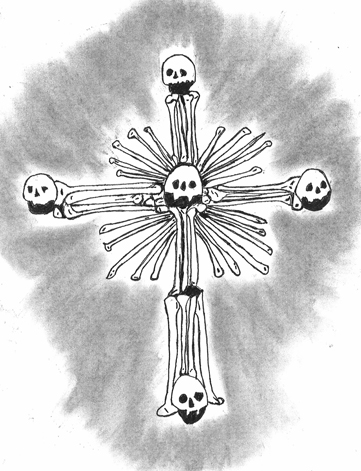
The store was large and on a quiet block of Chartres Street close to Canal and when I stepped inside it I discovered cooking classes were held in a large room beside the store. There was a class going on and I tried to listen in through the glass window that separated the spaces, but couldn’t make out what was being taught, so I wandered through the aisles of the store until I found the skull items. An artist had handcrafted the haunting skull designs onto a variety of bowls, mugs, plates, and shot glasses. They were beautiful, special, but as I looked at them, I couldn’t see how I would use or display them. I live in a tiny apartment in Manhattan and don’t entertain guests there, so the plates seemed a frivolous, unnecessary purchase to me. But sitting on a pedestal above their display was a ceramic vase, clearly created by the same artist but exceptionally different. It was about eight inches tall, with a design that seemed to be more Mexican than Creole, of a body of skeleton with a smiling skull with his arms reaching out around the curve of the vase. Behind the figure were circles—plates of colors, in complimentary shades of brown and red. I didn’t find it macabre at all. The design had a hint to the skulls you see on artwork created for the Day of the Dead festivals, the Mexican tradition that celebrates the spiritual journeys of family and friends who have died. It also reminded me of the skulls I had seen at the Sedlec Ossuary at Kutná Hora, a subterranean chapel outside of Prague which contains more than 70,000 skeletons, whose bones have been artistically arranged to form the decorations and furnishings of the chapel. I had stumbled onto it unexpectedly on a tour I had taken on a cold, rainy day. It had been a surprise to everyone on that tour—darting through the rain to find beautifully crafted rooms of skulls and bones fashioned into chandeliers, altars, coat-of-arms, crosses, and pyramids. It made everyone smile and laugh and cheer and celebrate—a joyous journey and transformation of a rainy day. It remains to this day one of the most enchanting spots I have ever visited.
I picked up the vase to examine it and check the price. It was pricey, but affordable. I put it down, circled the store, returned to look at the vase one last time, then decided I did not want to make an impulsive purchase so soon in my trip and wanted to see what I might find in other galleries, and if I saw nothing more compelling than the vase, then I would return and buy it. Maybe not today. But before I left New Orleans three days later.
The moment I was out of the store the fear that I would lose the vase overwhelmed me. What if someone found it as remarkable as I did? I walked along Chartres Street, visiting a bookstore and then a gallery where I saw many beautiful and desirable paintings, all too expensive or too large for my apartment. After an hour of wandering I was tired, my feet felt swollen, and I walked back to my hotel room to nap and rest before attending an event I had scheduled that afternoon. The hotel room was chilly and my T-shirt was damp from sweating, and I knew that if I didn’t change out of it, I might catch a cold, or something worse—I was at the age now, just past sixty, when colds could quickly develop into more serious problems. The need to change clothes, however, set off an alarm that I had under packed for the trip—something quite unusual for me. Usually I carry too much and too many things, but this time I was traveling with a small overnight bag and had purposely tried to pack only what I would essentially need.
Changed, dry, lying in the bed, I couldn’t relax because I was now fretting about food. In New York, I sometimes skip lunch, only eating a banana or an apple, trying to trick myself that less food means less calories and therefore less potential weight gain, when this doesn’t factor in, of course, all the alcohol I pour into my mouth in the evenings when I get home from my taxing day job. Still, in New York, I knew how to budget my hunger, something I never know how to do in New Orleans. I had purchased tickets for two theater productions that afternoon and I was worried that hunger from not having a proper lunch would pitch me into a headache, but I didn’t want to sit in a restaurant because I had scheduled a dinner at a nice restaurant with friends later that evening. As hard as it is to believe after seeing my waistline, I don’t like to eat out twice in one day.
I got out of bed, and stopped at the pharmacy to buy water and a tiny plastic bag of mixed nuts, the only healthy item I could find in the store—the shelves had been stripped bare of their nutrition and protein bars and there were no fresh fruits to be found (the edible kind)—and then headed to the theater on St. Peter’s Street. The first production, a one act play with three characters, was adequate. I wasn’t entirely bored, but I also wasn’t fully engaged, and it ended too soon and I found myself with more than an hour break before the next production began.
I knew that if I walked back to the hotel, I wouldn’t have the energy to walk back to the theater for the next performance I had bought tickets for. I no longer have that kind of stamina due to an ongoing health issue with my heart, so I sat in the lobby and read until it was deserted, then decided to walk and shop. I only ended up across the street, when I saw a store selling gelato. I rarely eat ice cream, I get swirls of gas in my intestines that never seem to disappear, just change positions, but I decided that a flavor titled “Bourbon Pecan” was too special to pass up, so I asked for a scoop and sat outside at a table and watched tourists wander along the street. Afterward, I shopped for the next forty minutes, feeling my feet swelling and my clothes growing damp. I was scheduled to attend a reception later at the far end of Royal Street before meeting my friends for dinner—at a restaurant further down Royal—and the thought of all that walking was now frightening and tiring me further. I texted my friend to see if he was attending the reception—he wasn’t—and if he was amenable to meeting at his hotel and eating nearby—he was—so I was relieved that the path forward for the rest of the day was now an easier one.

The second production was more interesting. Six actors performing unpublished short stories by Tennessee Williams written during the author’s early years living and working in St. Louis. St. Louis was also the setting of Williams’ earliest success on stage, The Glass Menagerie, but it’s safe to say that New Orleans was Williams’ spiritual home, a place that transformed and inspired him. Legend has it Williams had his first sexual encounter with another man in New Orleans, and the playwright later used the city as the setting for another one of his major successes, A Streetcar Named Desire. It’s also safe to state that he was the inspiration behind my trip to New Orleans. The conference I was attending, the Saints and Sinners Literary Festival, was now an adjunct of the larger Tennessee Williams/New Orleans Literary Festival.
After the show, I decided I would walk along Chartres Street toward my hotel, thinking maybe I might stop in to look at the vase in the cooking store again. I was tired, my head was spinning. I stood on a street corner, watching traffic, when I suddenly fell off the curb as if I had missed the step. I wasn’t walking. I had only been standing still, balancing myself as I checked the street traffic, waiting to cross the street. But it was as if I was drunk and had missed the curb. I felt the muscles in my left ankle twist as I caught myself and restored my balance. I’d spent more than two years trying to correct problems with my feet, first from bouts with gout, and then from a nasty sprain I had taken on a near tumble down the stairs of my apartment building while I was surreptitiously trying to dispose of my heavy apartment window air conditioner unit by leaving it at my building’s garbage site before anyone was awake.
As I waited for the traffic to clear and cross the street, I tested my weight on my foot, hoping I had not aggravated the healed sprain, and then had the sudden thought that maybe some supernatural force had pushed me off the curb. I like to believe in the myths and legends and ghosts of New Orleans, comically investing my own psychic superpowers on a minute by minute basis to ward off potential negative and destructive energy. But I also believe things happen for a reason. Something or someone pushed me off the curb. It was then that I decided that maybe luck wasn’t on my side on this trip and I should just purchase the vase before anything else happened to me.
Back at the store, I circled the skull plates and mugs, circled the vase, looked at the vase again, realized I was too exhausted to think properly, picked it up and carried it to the counter, telling a saleslady I wanted to have it shipped. I was looking in my wallet for my credit card and a business card with my address to give for the shipping address, when I heard a woman, not the clerk who was assisting me but another one, say, “Do you want to know something about that vase—and the artist who created it?”
I lifted my head up as if it had been preordained and said, “Yes.”
The saleslady, a nice looking short woman with long gray hair, said the artist was from Florida, used the moniker “Skullee,” and only sold his work in New Orleans in their store. He had no web site or email address to contact. She had never met him and the store communicated with him only for orders and payments. “He never names his art pieces,” she said. “But he named this one. Do you want to know what it’s called?”
“Yes, of course,” I answered.
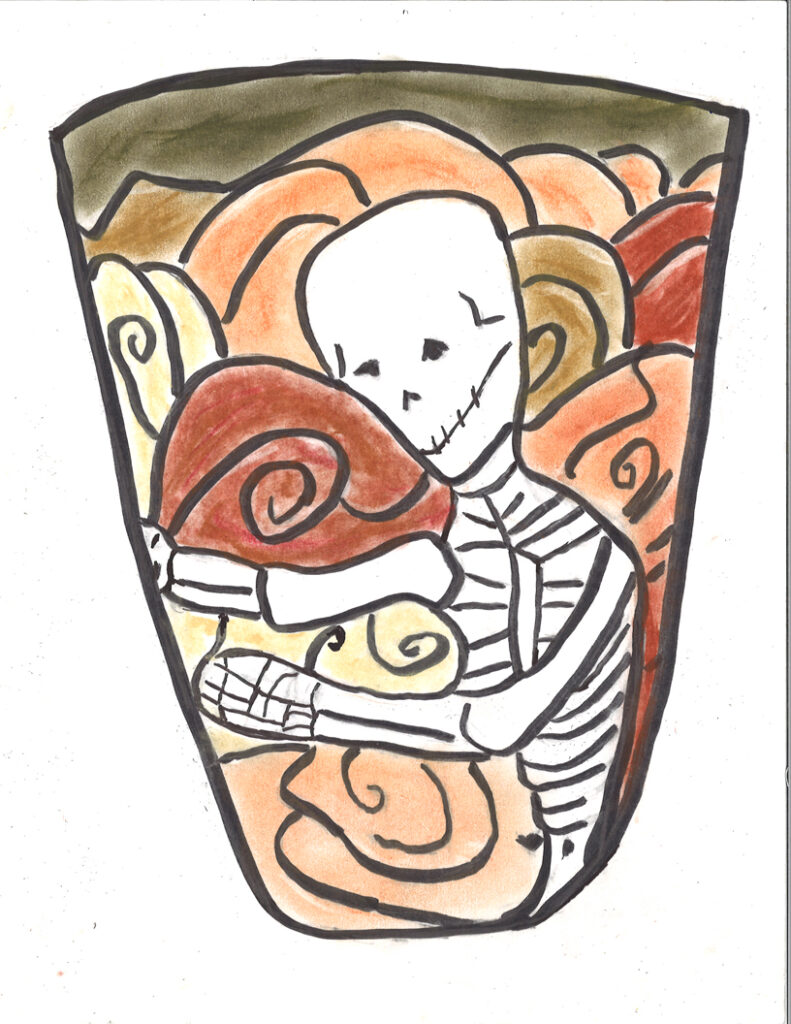
“The Happiness of Pursuit,” she said. “If you look, the figure of the skeleton is reaching around the vase in pursuit of something.”
I stood there and realized she had just explained my day. And my life. I took a photo of the vase before I left, stumbled back to my hotel shaking my head in disbelief and pleasure, just as I had done that rainy summer morning outside of Prague.
Later, after a nap, a shower, and a change of clothes, I met my friends for a dinner of Cajun flavored feasts, and shared the story I had of finding the vase and the photos I had snapped of it. I still had two more days in New Orleans, but a memory of the journey had already been made. And I am happy to report that nothing more momentous happened on the trip, good or bad, with the exception, of course, of falling in love again with the charms of the Big Easy.
_____
Author’s note: Skull plate and vase designs are by the artist Skullee. Illustrations of these artworks are by Jameson Currier. Sculptures and tableware by Skullee were sold in New Orleans and online by Crescent City Cooking School.


